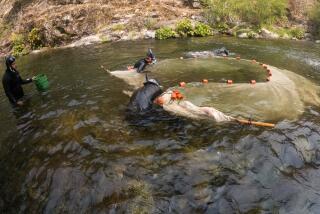Device to Help Salmon Survive Dams to Be Retested
- Share via
LOWER GRANITE DAM, Wash. — The U.S. Army Corps of Engineers spent more than $12.6 million to build and test a new device this spring to help young salmon swim safely over Northwest hydropower dams.
In the end, the results were inconclusive. But the corps isn’t giving up on the effort to restore depleted fish stocks in the Pacific Northwest. The test run will be repeated next spring and summer.
The corps’ 4-million-pound, 350-foot-long steel prototype “surface collector” is designed to divert fish away from deadly turbines and help them over the spillway of this Snake River dam in southeast Washington.
This year’s test was delayed nearly a month by construction problems and high water--spring flows were double the annual average. The test measured only the last five weeks of spring runs to the sea by steelhead and threatened Idaho Chinook salmon.
When the test finally got underway, one count indicated that fewer than one in five ocean-bound fish went through the collector, which is suspended over three of six turbine intakes on the dam’s fore bay, or upstream side.
The corps, which operates eight of 13 dams on the Snake-Columbia river system, is expected to spend an additional $6 million next year to test the device through the entire spring run and the summer run of threatened fall Chinook.
Corps officials defended the test and the decision to try again.
“As in any kind of research, you like to replicate your results, especially when so much is at stake, financially as well as biologically,” said Mike Mason, the corps’ project manager. “There was no difficulty getting agreement that the right thing to do was retest the structure with some modifications.”
Driving the surface-collector tests is a 1995 National Marine Fisheries Service “biological opinion” on hydropower operations--the basis of the region’s long-term plan to restore threatened fish stocks.
The opinion sets a goal of getting 80% of the threatened or endangered fish from Idaho through the Snake and Columbia river dams. The fisheries service is to make a final decision in 1999 on how to accomplish this, in large part using data gathered by the corps’ tests.
Many hydroelectric dams built in the Northwest since the late 1930s have “ladders” that help adult fish get upstream to spawn, but they lack devices to help ocean-bound young fish.
Tests of various ways to help get fish safely downstream will partly determine the best use of the hundreds of millions of dollars spent each year on salmon-saving programs.
The Bonneville Power Administration, which sells electricity produced at federal dams in the Northwest, budgets about $435 million annually for fish and wildlife conservation programs. About $125 million of that goes directly to salmon-saving efforts.
Surface collectors being used or tested on Columbia River dams have shown promise.
An operating collector at Wells Dam, run by the Douglas County Public Utility District upstream from Wenatchee, sends as much as 95% of ocean-bound salmon over that dam’s spillway. Its success rate is due partly to the dam’s design, with the spillway over the powerhouse rather than alongside like the Snake River dams.
Similar collectors also are being tested at a Grant County Public Utility District dam on the Columbia.
Young salmon and steelhead making their way to the ocean now have three ways of getting past hydroelectric dams: over spillways, by barge, or through the powerhouse turbines.
Fish fare poorly in the turbines, whose whirling blades help churn water power into electrical power.
Indian tribes and some state and federal fish agencies for years have questioned the effectiveness of barging--collecting young fish above the dams and boating them through the locks. About 50% of the migrating fish are barged most years, though the figure can be as high as 80%.
As for the spillways, high water this spring swept most of the fish over them and on downstream. But in low-water years, diverting additional water over the spillways to help the fish leaves less water available for electricity production, commercial shipping and irrigation. That method has drawn resistance from utilities, industry and agribusiness.
The corps also is studying other options, including reservoir draw-downs and improvements to diversion screens in front of turbine intakes.
More to Read
Sign up for Essential California
The most important California stories and recommendations in your inbox every morning.
You may occasionally receive promotional content from the Los Angeles Times.













